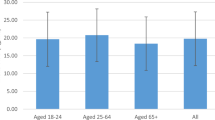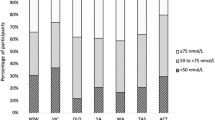Abstract
BACKGROUND/OBJECTIVES:
Vitamin D deficiency, a risk factor for osteomalacia and osteoporosis, is a re-emerging health problem globally. While sunlight is an important vitamin D source, previous investigations among women whose culture encourages skin covering have been small, not nationally representative, or both. We investigated serum 25–hydroxyvitamin D (25(OH)D3) status and factors associated with deficiency in a nationally representative survey of 2013 Jordanian women of reproductive age in Spring 2010.
SUBJECTS/METHODS:
We measured 25(OH)D3 concentrations by liquid chromatography-tandem mass spectrometry and calculated prevalence ratios for deficiency associated with skin covering and other factors.
RESULTS:
Results showed 60.3% (95% CI: 57.1–63.4%) deficiency (<12 ng/ml) and 95.7% (95% CI: 94.4–96.8%) insufficiency (<20 ng/ml) among women. Prevalence of deficiency was 1.60 times higher for women who covered with a scarf/hijab (95% CI: 1.06–2.40, P=0.024) and 1.87 times higher for women who wore full cover, or a niqab (95% CI: 1.20–2.93, P=0.006), compared with the women who did not wear a scarf/hijab or niqab. Compared with rural women completing at least secondary education, prevalence of deficiency was 1.30 times higher for urban women of the same education level (95% CI: 1.08–1.57, P=0.006), 1.18 times higher for urban women completing less than secondary education (95% CI: 0.98–1.43, P=0.09), and 0.66 times lower for rural women completing less than secondary education (95% CI: 0.52–0.84, P=0.001).
CONCLUSION:
Vitamin D deficiency and insufficiency pose significant public health problems in Jordanian women. Prevalence of deficiency is significantly higher among urban women and among women who cover with a scarf/hijab or niqab.
This is a preview of subscription content, access via your institution
Access options
Subscribe to this journal
Receive 12 print issues and online access
$259.00 per year
only $21.58 per issue
Buy this article
- Purchase on Springer Link
- Instant access to full article PDF
Prices may be subject to local taxes which are calculated during checkout


Similar content being viewed by others
References
Mithal A, Wahl DA, Bonjour JP, Burckhardt P, Dawson-Hughes B, Eisman JA et al. Global vitamin D status and determinants of hypovitaminosis D. Osteoporos Int 2009; 20, 1807–1820.
DeLuca HF . The Vitamin D story: a collaborative effort of basic science and clinical medicine. FASEB J 1988; 2, 224–236.
Holick MF . Vitamin D. In: Shiles ME, Olson JA, Shike M, Ross CA (eds). Modern Nutrition in Health and Disease, 9th edn. Williams & Williams: Baltimore, MD, USA, 1999, pp 329–345.
Reichel H, Koeffler HP, Norman AW . The role of vitamin D endocrine system in health and disease. N Engl J Med 1989; 320, 980–991.
IOM. Dietary Reference Intake for Calcium and Vitamin D. National Academies Press: Washington, DC, 2011.
Holick MF . High prevalence of vitamin D inadequacy and implications for health. Mayo Clin Proc 2006; 81, 353–373.
Nesby-O’Dell S, Scanlon KS, Cogswell ME, Gillespie C, Hollis BW, Looker AC et al. Hypovitaminosis D prevalence and determinants among African American and white women of reproductive age: third National Health and Nutrition Examination Survey, 1988–1994. Am J Clin Nutr 2002; 76, 187–192.
Gannagé-Yared MH, Chemali R, Yaacoub N, Halaby G . Hypovitaminosis D in a sunny country: relation to lifestyle and bone markers. J Bone Miner Res 2000; 15, 1856–1862.
Holick MF . Environmental factors that influence the cutaneous production of vitamin D. Am J Clin Nutr 1995; 61, 638–645.
Clemens TL, Adams JS, Henderson SL, Holick MF . Increased skin pigment reduces the capacity of skin to synthesize vitamin D3 . Lancet 1982; 1, 74–76.
Holick MF . Vitamin D deficiency. N Engl J Med 2007; 357, 266–281.
Meddeb N, Sahli H, Chahed M, Abdelmoula J, Feki M, Salah H et al. Vitamin D deficiency in Tunisia. Osteoporos Int 2005; 16, 180–183.
Gharaibeh MA, Stoecker BJ . Assessment of serum 25(OH)D concentration in women of childbearing age and their preschool children in Northern Jordan during summer. Eur J Clin Nutr 2009; 63, 1320–1326.
Allali F, El Aichaoui S, Khazani H, Benyahia B, Saoud B, El Kabbaj S et al. High prevalence of hypovitaminosis D in Morocco: relationship to lifestyle, physical performance, bone markers, and bone mineral density. Semin Arthritis Rheum 2009; 38, 444–451.
Rassoull A, Milanian I, Moslemi-Zadeh M . Determination of serum 25-hydroxyvitamin D3 levels in early postmenopausal Iranian women: relationship with bone mineral density. Bone 2001; 29, 428–430.
Shilbayeh S . Prevalence of osteoporosis and its reproductive risk factors among Jordanian women: a cross-sectional study. Osteoporos Int 2003; 14, 929–940.
Alagöl F, Shihadeh Y, Boztepe H, Tanakol R, Yarman S, Azizlerli H et al. Sunlight exposure and vitamin D deficiency in Turkish women. J Endocrinol Invest 2000; 23, 173–177.
Batieha A, Khader Y, Jaddou H, Hyassat D, Batieha Z, Khateeb M et al. Vitamin D status in Jordan: dress style and gender discrepancies. Ann Nutr Metab 2011; 58, 10–18.
Dawodu A, Absood G, Patel M, Agarwal M, Ezimokhai M, Abdulrazzaq Y et al. Biosocial factors affecting vitamin D status of women of childbearing age in the United Arab Emirates. J Biosoc Sci 1998; 30, 431–437.
el-Sonbaty MR, Abdul-Ghaffar NU . Vitamin D deficiency in veiled Kuwaiti women. Eur J Clin Nutr 1996; 50, 315–318.
Gannagé-Yared MH, Maalouf G, Khalife S, Challita S, Yaghi Y, Ziade N et al. Prevalence and predictors of vitamin D inadequacy amongst Lebanese ostoporotic women. Br J Nutr 2009; 101, 487–491.
Güler T, Sivas F, Ba°kan BM, Günesen O, Alemdaro∂lu E, Ozoran K . The effect of outfitting style on bone mineral density. Rheumatol Int 2007; 27, 723–727.
Guzel R, Kozanoglu E, Guler-Uysal F, Soyupak S, Sarpel T . Vitamin D status and bone mineral density of veiled and unveiled Turkish women. J Womens Health Gend Based Med 2001; 10, 765–770.
Hobbs RD, Habib Z, Alromaihi D, Idi L, Parikh N, Blocki F et al. Severe vitamin D deficiency in Arab-American women living in Dearborn, Michigan. Endocr Pract 2009; 15, 35–40.
Mishal AA . Effects of different dress styles on vitamin D levels in healthy young Jordanian women. Osteoporos Int 2001; 12, 931–935.
World Climate Guide. Jordan Climate Guides (cited 16 December 2011). Available from http://www.worldclimateguide.co.uk/climateguides/jordan/.
Roth HJ, Schmidt-Gayk H, Weber H, Niederau C . Accuracy and clinical implications of seven 25-hydroxyvitamin D methods compared with liquid chromatography-tandem mass spectrometry as a reference. Ann Clin Biochem 2008; 45, 153–159.
Division of Nutrition, Physical Activity and Obesity, National Center for Chronic Disease Prevention and Health Promotion. Vitamin A Laboratory External Quality Assurance Program, (Internet) 26 May 2009; (cited 2 February 2012). Available from http://www.cdc.gov/immpact/projects/initiatives/vitamina.html.
Bursac Z, Gauss CH, Williams DK, Hosmer DW . Purposeful selection of variables in logistic regression. Source Code Biol Med 1998; 3, 17.
Fuleihan GE, Deeb M . Hypovitaminosis D in a sunny country. N Engl J Med 1999; 340, 1840–1841.
DEQAS Report. Charing Cross Hospital: London, UK, 2011.
Islam MZ, Akhtaruzzaman M, Lamberg-Allardt C . Hypovitaminosis D is common in both veiled and nonveiled Bangladeshi women. Asia Pac J Clin Nutr 2006; 15, 81–87.
MacLaughlin J, Holick MF . Aging decreases the capacity of human skin to produce vitamin D3. J Clin Invest 1985; 76, 1536–1538.
Hashemipour S, Larijani G, Adibi H, Javadi E, Sedaghat M, Pajouhi M et al. Vitamin D deficiency and causative factors in the population of Tehran. BMC Public Health 2004; 4, 38.
Sedrani SH, Elidrissy AW, El Arabi KM . Sunlight and vitamin D status in normal Saudi subjects. Am J Clin Nutr 1983; 38, 129–132.
Dawson-Hughes B, Harris SS, Dallal GE . Plasma calcidiol, season, and serum parathyroid hormone concentrations in healthy elderly men and women. Am J Clin Nutr 1997; 65, 67–71.
Jacques PF, Felson DT, Tucker KL, Mahnken B, Wilson PW, Rosenberg IH et al. Plasma 25-hydroxyvitamin D and its determinants in an elderly population sample. Am J Clin Nutr 1997; 66, 929–936.
VanAmerongen BM, Dijkstra CD, Lips P, Polman CH . Multiple sclerosis and vitamin D: an update. Eur J Clin Nutr 2004; 58, 1095–1109.
Allen L, de Benoist B, Dary O, Hurrell R . Guidelines on Food Fortification with Micronutrients,. World Health Organization, Food and Agricultural Organization of the United Nations, WHO Press: Geneva, Switzerland: 2006, p 376.
Natri AM, Salo P, Vikstedt T, Palssa A, Huttunen M, Kärkkäinen MU et al. Bread fortified with cholecalciferol increases the serum 25-hydroxyvitamin D concentration in women as effectively as a cholecalciferol supplement. J Nutr 2006; 136, 123–127.
A2Z, United States Agency for International Development (USAID), Academy for Educational Development (AED), Palestinian Authority, American Near East Refugee Aid (ANERA). Determining the Dietary Patterns and Biochemical Markers Among Women and Children in Hebron and Gaza City: A2Z Project–2010 (cited 10 August 2011). Available from http://www.a2zproject.org/pdf/Dietary_SURVEY.pdf.
Acknowledgements
The current survey was funded through a grant agreement between the Global Alliance for Improved Nutrition (GAIN) and the Government of Jordan Ministry of Health and through a Memorandum of Understanding between GAIN and CDC. We especially acknowledge Usha Manadava and Rosemary Schleicher for their laboratory support, and Faruq Zghol, Iyad Hamzeh and Ashraf Mettlaq for helping in the vitamin D laboratory analyses. We would also like to thank Hanan Masa’d, Rawhieh Barham, Aktham Haddadin, Tarek Al-Sanouri, Mohammed Tarawaneh, Bassam Hijawi, and the many individuals who assisted in the completion of the micronutrient survey.
Disclaimer
The findings and conclusions in this report are those of the authors and do not necessarily represent the official position of the Centers for Disease Control and Prevention.
Author information
Authors and Affiliations
Corresponding author
Ethics declarations
Competing interests
The authors declare no conflict of interest.
Rights and permissions
About this article
Cite this article
Nichols, E., Khatib, I., Aburto, N. et al. Vitamin D status and determinants of deficiency among non-pregnant Jordanian women of reproductive age. Eur J Clin Nutr 66, 751–756 (2012). https://doi.org/10.1038/ejcn.2012.25
Received:
Revised:
Accepted:
Published:
Issue Date:
DOI: https://doi.org/10.1038/ejcn.2012.25
Keywords
This article is cited by
-
Optimizing ultraviolet B radiation exposure to prevent vitamin D deficiency among pregnant women in the tropical zone: report from cohort study on vitamin D status and its impact during pregnancy in Indonesia
BMC Pregnancy and Childbirth (2019)
-
Vitamin D status and associated factors of deficiency among Jordanian children of preschool age
European Journal of Clinical Nutrition (2015)
-
Serum C3 epimer of 25-hydroxyvitamin D and its determinants in adults: a national health examination survey in Thais
Osteoporosis International (2015)
-
Relationship between 25-hydroxyvitamin D concentrations, serum calcium, and parathyroid hormone in apparently healthy Syrian people
Archives of Osteoporosis (2014)



